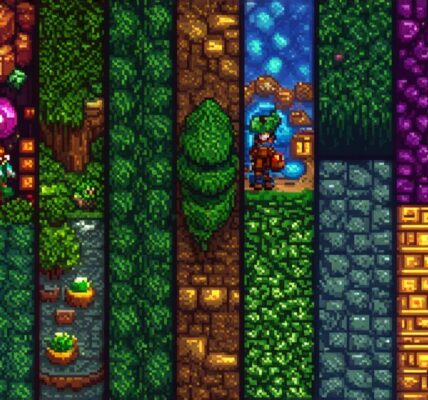
The Foundation of a Great Game
The gameplay mechanics of a video game are the building blocks upon which everything else rests. A well-designed gameplay system ensures that players are engaged and challenged, while also providing a sense of satisfaction and accomplishment.
Grading Gameplay Mechanics
- Challenge: The game should provide a good balance of challenge and progression. Players should feel both frustrated and rewarded as they overcome obstacles and reach new milestones.
- Replayability: A game that offers multiple paths to completion or hidden content encourages players to return and explore further. This can increase the game’s lifespan and replay value.
- Depth: The game should offer a variety of gameplay experiences, such as puzzles, combat, exploration, and social interactions. A more diverse range of activities keeps players engaged and prevents boredom.
- Intuitiveness: The controls and mechanics should be easy to learn and use. Players should be able to understand how the game works without needing extensive tutorials or explanations.
- Feedback: The game should provide clear and immediate feedback on player actions. This helps players understand their progress and make informed decisions about how to proceed.
Case Study: Super Mario 64
Super Mario 64, released in 1996 for the Nintendo 64, is widely regarded as one of the greatest video games of all time. Its innovative gameplay mechanics, including a fully explorable 3D world and non-linear level design, set new standards for platformers and influenced countless subsequent games.
Grading Super Mario 64’s Gameplay Mechanics
- Challenge: The game presents players with a variety of obstacles and enemies to overcome, ranging from simple jumping puzzles to more complex combat encounters. The game also offers multiple paths to completion, allowing players to choose their own challenges.
- Replayability: Super Mario 64’s expansive world and non-linear level design encourage exploration and discovery, leading to countless hours of playtime. The game also features hidden secrets and collectibles that reward players for exploring further.
- Depth: Super Mario 64 offers a variety of activities, including platforming, puzzle solving, and combat. The game’s diverse range of experiences keeps players engaged and prevents boredom.
- Intuitiveness: The game’s controls are intuitive and easy to learn, with simple actions like jumping and running. Players can quickly understand how the game works and begin playing without needing extensive tutorials.
- Feedback: Super Mario 64 provides clear feedback on player actions, with visual and auditory cues indicating when players have successfully completed a task or failed to do so. This helps players understand their progress and make informed decisions about how to proceed.
Storytelling: The Heart of a Great Game World
A well-crafted story adds depth and meaning to a game world, helping to immerse players in the game’s universe and engage them emotionally.
Grading a Game’s Storytelling
- Characters: The game’s characters should be well-developed and relatable, with distinct personalities and motivations that drive the plot forward.
- Plot: The game’s plot should be engaging and unpredictable, with twists and turns that keep players on their toes. The story should also tie into the gameplay mechanics, enhancing the overall experience.
- Setting: The game’s world should be richly detailed and immersive, with a unique atmosphere and cultural elements that feel authentic and believable.
- Narrative Style: The game’s narrative style should match the tone and genre of the game, whether it’s a serious drama, a lighthearted comedy, or an action-packed adventure.
- Emotional Impact: The game’s story should evoke strong emotions in players, whether it’s joy, sadness, fear, or anger. A powerful emotional connection can make the game world feel more real and memorable.
Case Study: The Last of Us
The Last of Us, released in 2013 for PlayStation 3 and 4, is a critically acclaimed video game that tells a compelling story through its characters and gameplay mechanics.
Grading The Last of Us’s Storytelling
- Characters: The game’s main character, Ellie, is a complex and relatable protagonist with a tragic backstory and a strong sense of loyalty to her companion, Joel. The supporting characters are also well-developed, adding depth and diversity to the story.
- Plot: The game’s plot is full of twists and turns, with unexpected events that keep players on their toes. The story also ties into the gameplay mechanics, with moments of stealth and combat that add tension and excitement.
- Setting: The Last of Us takes place in a post-apocalyptic world filled with danger and despair. The game’s detailed environments and atmospheric sound design help to create a sense of foreboding and unease.
- Narrative Style: The Last of Us uses a variety of narrative techniques, including flashbacks and dream sequences, to tell its story in a way that is both engaging and thought-provoking.
- Emotional Impact: The game’s emotional intensity is one of its most powerful aspects, with moments of heartbreak and triumph that leave a lasting impression on players. The story’s themes of loss, sacrifice, and survival are also deeply resonant and meaningful.
Visuals: The Eyes and Ears of the Player
The visuals of a video game can greatly enhance or detract from the overall experience, with stunning graphics and immersive environments helping to draw players into the game world.
Grading a Game’s Visuals
- Art Style: The game’s art style should match the tone and genre of the game, whether it’s realistic, stylized, or cartoonish. A consistent art style helps to create a cohesive and believable world.
- Detail: The game’s environments and characters should be detailed and well-crafted, with textures, lighting, and shadows that add depth and realism.
- Animation: The game’s animation should be fluid and natural, with movements that feel realistic and believable. Good animation can help to create a more immersive experience for players.
- Color: The game’s color palette should be carefully chosen to enhance the mood and atmosphere of the game world. Color can also be used to draw attention to important elements in the game, such as enemies or collectibles.
- Sound Design: The game’s sound design should be immersive and believable, with realistic sound effects and atmospheric music that add to the overall experience.
Case Study: Uncharted 4: A Thief’s End
Uncharted 4: A Thief’s End, released in 2016 for PlayStation 4, is a visually stunning video game that showcases the power of next-generation graphics and immersive environments.
Grading Uncharted 4’s Visuals
- Art Style: The game uses a realistic art style that accurately represents its tropical setting, with lush jungles and ruins. This helps to create an immersive and believable world.
- Detail: Uncharted 4’s environments are incredibly detailed, with textures, lighting, and shadows that add depth and realism. The game’s characters are also well-crafted, with realistic animations and facial expressions.
- Animation: The game’s animation is fluid and natural, with movements that feel realistic and believable. This helps to create a more immersive experience for players.
- Color: Uncharted 4’s color palette is carefully chosen to enhance the mood and atmosphere of the game world. The game’s tropical setting is beautifully rendered, with vibrant colors that make the environment feel alive and immersive.
- Sound Design: Uncharted 4’s sound design is immersive and believable, with realistic sound effects and atmospheric music that add to the overall experience. The game’s score is also memorable and adds to the emotional impact of key moments in the story.




